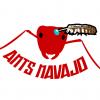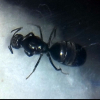One of my Formica Fusca colonies is on a DIY plaster formicarium that has 4 areas: top, front, left and right sides. It has hydration sponges on both sides and on the top. They have a small outworld, with a 2.5ml syringe with water and a cotton stopper.
Queen + 5 nanitics, so small family but with lots of brood on it's way, I'm expecting my 1st population boom soon and can't wait for it.
Never thought about a thousand ants bringing enough moisture to the nest, but it makes sense. And since I only have 6, I have to give them their water.
Me's still a noob and I was guessing how much of a moist environment they would like and now I'm realizing they like it somehow moist. Yesterday I saw the nanies moving around a lot and most of them were in the outworld inside the water syringe and nearby the cotton. They're thirsty, I thought, and I should grab a syringe and inject some water on their nest's water chambers.
Looking closer I've realized they had already moved a lot of brood into that water syringe. So their nest was sure feeling dry. The queen was still there but she even took a walk outside of her chamber on the left side of the formicarium into the top chamber but then returned back. But she was already planning to move since she gathered a massive pile of brood and tried lifting it. I got impressed!
I've started injecting water but the nanies were still carrying brood after that. I've injected some more water and the queen stayed put and after some hours most brood was brought back. I don't know if there are still some left back by the water, the eggs and larva are pretty confusable with sand grains.
So I ended up injecting a total of around 7 ml of water (2ml on the queen's side, 2.5 on the opposite side and another 2.5 on the top) for a 5cm tall x 8.5 wide x 8.5 deep formicarium.
So yeah these few small kids need water in their home. I'm planning to give them 3ml on the queen's side and on the top, alternatively every 3 days and lets see how it goes from there.
I was planning to do some alternate hydration on the left and right side, but the entrance for the right side got blocked by a dead fly!  And I start to suspect they've done this on purpose. The formicarium is way too large for them, so blocking that hole will block access to the front and left side (they were using it a bit as a fly cemetery). So a smaller home is easier to defend and safer, I understand that.
And I start to suspect they've done this on purpose. The formicarium is way too large for them, so blocking that hole will block access to the front and left side (they were using it a bit as a fly cemetery). So a smaller home is easier to defend and safer, I understand that.
So I'm not putting water on the blocked right side and that's one less area I have to worry about mold. If in the future they want to reclaim those areas, let them unclog that entrance.
And I even think they've dumped some larva on top of that fly's cadaver. Personal dead fat security guard and feeding the kids. How useful! 

















